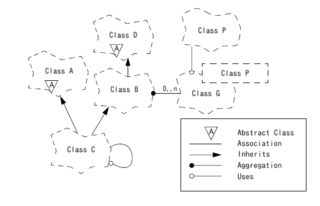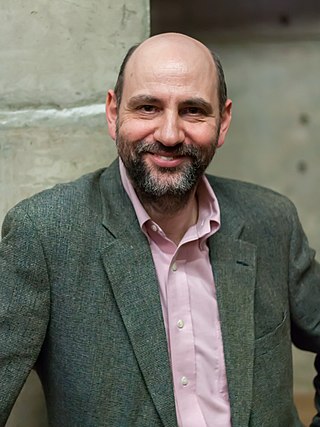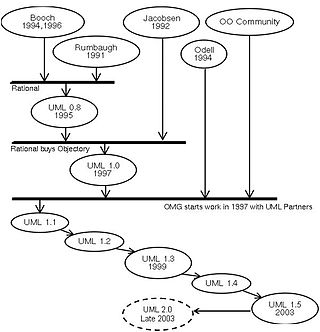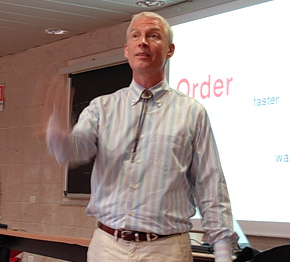
The Booch method is a method for object-oriented software development. It is composed of an object modeling language, an iterative object-oriented development process, and a set of recommended practices.

Martin Fowler is a British software developer, author and international public speaker on software development, specialising in object-oriented analysis and design, UML, patterns, and agile software development methodologies, including extreme programming.

An object-modeling language is a standardized set of symbols used to model a software system using an object-oriented framework. The symbols can be either informal or formal ranging from predefined graphical templates to formal object models defined by grammars and specifications.

The unified modeling language (UML) is a general-purpose visual modeling language that is intended to provide a standard way to visualize the design of a system.

Grady Booch is an American software engineer, best known for developing the Unified Modeling Language (UML) with Ivar Jacobson and James Rumbaugh. He is recognized internationally for his innovative work in software architecture, software engineering, and collaborative development environments.

Craig Larman is a Canadian computer scientist, author, and organizational development consultant. With Bas Vodde, he is best known for formulating LeSS, and for several books on product and software development.

Edward Nash Yourdon was an American software engineer, computer consultant, author and lecturer, and software engineering methodology pioneer. He was one of the lead developers of the structured analysis techniques of the 1970s and a co-developer of both the Yourdon/Whitehead method for object-oriented analysis/design in the late 1980s and the Coad/Yourdon methodology for object-oriented analysis/design in the 1990s.
A data-flow diagram is a way of representing a flow of data through a process or a system. The DFD also provides information about the outputs and inputs of each entity and the process itself. A data-flow diagram has no control flow — there are no decision rules and no loops. Specific operations based on the data can be represented by a flowchart.
Feature-driven development (FDD) is an iterative and incremental software development process. It is a lightweight or agile method for developing software. FDD blends several best practices into a cohesive whole. These practices are driven from the perspective of delivering functionality (features) valued by the client. Its main purpose is to deliver tangible, working software repeatedly in a timely manner in accordance with the Principles behind the agile manifesto.
The Shlaer–Mellor method, also known as object-oriented systems analysis (OOSA) or object-oriented analysis (OOA) is an object-oriented software development methodology introduced by Sally Shlaer and Stephen Mellor in 1988. The method makes the documented analysis so precise that it is possible to implement the analysis model directly by translation to the target architecture, rather than by elaborating model changes through a series of more platform-specific models. In the new millennium the Shlaer–Mellor method has migrated to the UML notation, becoming Executable UML.
UML color standards are a set of four colors associated with Unified Modeling Language (UML) diagrams. The coloring system indicates which of several archetypes apply to the UML object. UML typically identifies a stereotype with a bracketed comment for each object identifying whether it is a class, interface, etc.
Object-oriented analysis and design (OOAD) is a technical approach for analyzing and designing an application, system, or business by applying object-oriented programming, as well as using visual modeling throughout the software development process to guide stakeholder communication and product quality.
Together is a product from OpenText, formerly from Micro Focus, formerly from Borland, formerly from TogetherSoft, that currently integrates a Java IDE, which originally had its roots in JBuilder, with an UML modeling tool.
Borland C++ was a C and C++ IDE released by Borland for MS-DOS and Microsoft Windows. It was the successor to Turbo C++ and included a better debugger, the Turbo Debugger, which was written in protected mode DOS.
Kevin C. Lano is a British computer scientist.
The Toolkit for Conceptual Modeling (TCM) is a collection of software tools to present specifications of software systems in the form of diagrams, tables, trees, and the like. TCM offers editors for techniques used in Structured Analysis as well as editors for object-oriented (UML) techniques. For some of the behavior specification techniques, an interface to model checkers is offered. More in particular, TCM contains the following editors.

In software engineering, structured analysis (SA) and structured design (SD) are methods for analyzing business requirements and developing specifications for converting practices into computer programs, hardware configurations, and related manual procedures.
Stephen J. Mellor is an American computer scientist, developer of the Ward–Mellor method for real-time computing, the Shlaer–Mellor method, and Executable UML, and signatory to the Agile Manifesto.
Open ModelSphere was a data, process and UML modeling tool written in Java and distributed as free software under the GPL License. It provided support for forward and reverse engineering between UML and relational schemas.
UML is a modeling language used by software developers. UML can be used to develop diagrams and provide users (programmers) with ready-to-use, expressive modeling examples. Some UML tools generate program language code from UML. UML can be used for modeling a system independent of a platform language. UML is a graphical language for visualizing, specifying, constructing, and documenting information about software-intensive systems. UML gives a standard way to write a system model, covering conceptual ideas. With an understanding of modeling, the use and application of UML can make the software development process more efficient.









